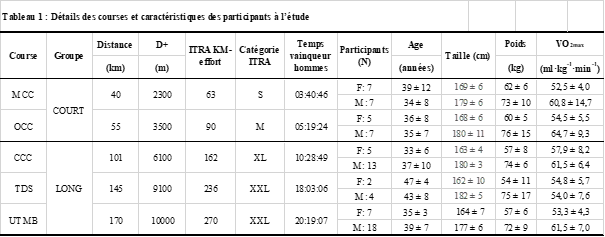Fatigue in trail running: interactions between sex and race distanceMain findings of the UTMB 2019 study
Introduction: The results of this study was analyzed only a few months after the UTMB 2019. Yet in order to communicate, we had to wait for the publication of all the results in scientific journals. This is now done. Thus, this document is a synthesis of 6 articles validated by the international scientific community: Medicine & Science in Sports & Exercise, Scandinavian Journal of Medicine & Science in Sports, Experimental Physiolology, The International Journal of Sports Physiology and Performance, European Journal of Applied Physiology, International Journal of Molecular Sciences.
Rationale of the study
Although ultra-endurance running events (ultra-trail in particular) have become extremely popular over the last twenty years, the physiological consequences are not yet fully understood, especially for women. Generally speaking, twice as many men are recruited to scientific studies in the field of exercise physiology. Despite the results obtained in men cannot be directly transferred to women, particularly when talking about fatigue or running. Our previous work on the UTMB® aimed to understand the differences between men and women and showed that calf muscle fatigue (i.e. decrease in force evoked by electrical stimulation) and the loss of maximum quadriceps force were less in women than in men after a 110 km ultra-trail (shortened version of the UTMB® 2012). However, there was no difference in central fatigue (role of the brain) between the sexes. This unique result in the scientific literature had to be confirmed. We also wanted to know if this remained true for longer distances ... and shorter ones. Furthermore, the question of the influence of fatigue induced by different distances on the energy cost of running remains discussed. The role of dehydration on blood viscosity is also unknown. In order to evaluate the effects of sex and distance on fatigue induced by an ultra-marathon, our experimental approach considered the multifactorial dimension of fatigue by emphasizing: (i) the potential neuromuscular origins of fatigue (ii) the influence on energy cost, (iii) the hemorheological consequences.
Experimental Protocol
This was a prospective pathophysiology study of male and female runners participating in one of the 2019 UTMB races (Table 1). We compared a group of men vs. a group of women running various distances (races greater than 100 km vs. races less than 60 km) with pre-post race comparisons (each subject being their own control).
Study participants completed 3 visits:
(i) an inclusion visit #1 with a physician at the LIBM lab in Saint-Etienne. This visit also allowed to measured VO2max (graded treadmill running) and to familiarize the participants with the experimental devices and methods;
(ii) a pre-race visit #2 (in the week preceding the race) during which various tests were carried out: on a dynamometer (fatigue assessment in isometric mode), with transcranial magnetic stimulation and peripheral nerve electrical stimulation (photo 1), on a bicycle ergometer (fatigue assessment in dynamic mode) to determine power and maximal velocity (photo 2), on a treadmill (energy cost during level and uphill running, photo 3), blood sampling (photo 4);
(iii) a post-race visit #3 (within one hour of the race): same assessments as visit #2.
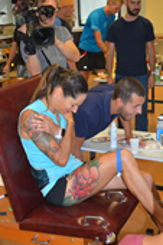
Photo 1 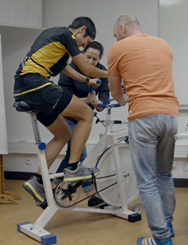
Photo 2 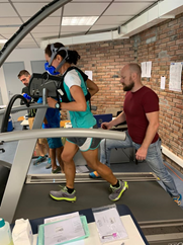
Photo 3 
Photo 4
Visits #2 and #3 took place at the National Ski and Mountaineering School in Chamonix. Muscle and tendon stiffness (photo 5) and soft tissue vibration during running (photo 6) were also quantified but the results are not yet published and will thus not be presented here. For the sex comparison, men and women were matched by relative level of performance, i.e. having performed at a similar percentage of the time of the male and female winners of each race.

Photo 5 
Photo 6
Main findings
The main objective of the 1st article (published in Med Sci Sports Exerc, 1st author: Thibault Besson) was to determine whether the sex of the participants had an effect on the magnitude of neuromuscular fatigue and the degradation of energy cost. Our results confirmed our 2012 study, i.e., women were less fatigued after the races, as evidenced, for example, by a smaller decrease in maximal quadriceps strength (Figure 1A). Contrary to our assumption that this lower fatigue compared to men would be especially true for ultra-marathon, these differences existed independently of distance. In fact, it was almost the opposite, as the women had less muscle fatigue than the men for the SHORT distance and not for the LONG distance. Note that less fatigue does not necessarily (or only) mean better fatigue resistance. Indeed, this result could be due, at least in part, to sex differences in competition intentions that were questioned after the races: on average, women said that they were more in pleasure mode and men more in competition mode (Figure 1B).
Although difficult to interpret, we also found, using the magnetic stimulation of the cerebral motor cortex (photo 1), a difference between the sexes in terms of changes in brain excitability with fatigue: this increase was only present in men. Furthermore, although the statistics did not allow for significant conclusions, it seems that the differences in neuromuscular fatigue between the sexes had an impact on the energy cost, since this cost seemed to deteriorate less in women, whether level or uphill running (Figure 2). Further studies are needed to confirm this result.

Figure 1. Total fatigue in the quadriceps (= decrease in maximal voluntary strength, panel A) and running intentions (panel B) in women (red) and men (blue). All distances were mixed. The bold lines on panel A represent the mean. On panel B, a lower number corresponds to a competitive intention vs. pleasure mode.
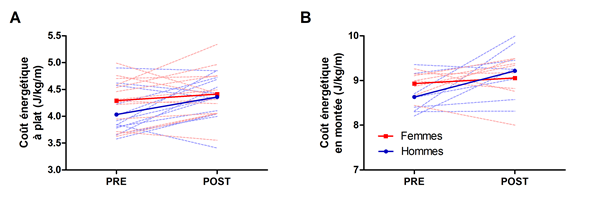
Figure 2. Deterioration in energy cost (= increase in energy expenditure required to run one meter) with fatigue in women (red) and men (blue) during level (panel A) and uphill (15% grade, panel B) treadmill running. All distances were mixed. Bold lines represent the mean.
The 2nd and 3rd articles (published in Scand J Med Sci Sports and Exp Physiol, 1st author: John Temesi and Loïc Espeit, respectively) focused on the effect of running distance on fatigue. By comparing several studies, we had observed (Millet GY, Sports Med, 2011) that running-induced fatigue, determined by the decrease in quadriceps maximal strength, increased with exercise duration up to ~15 hours and then plateaued (or even decreased on the Tor des Géants!). The objective of the present study was therefore to investigate this question directly by comparing shorter trail races and longer ultra-trail races with similar terrain and weather conditions. We confirmed the influence of race distance on quadriceps strength decline (Figure 3A) (as well as on intracerebral inhibition parameters related to muscle contraction or blood indices of muscle damage) but surprisingly, race distance had no effect on calf muscle fatigue (Figure 3B). While we speculated that the increase in central fatigue (i.e. a decrease in the capacity of the nervous system to command the quadriceps muscles) would occur for longer distances, this did not happen: the decrease in the level of voluntary activation (VA in Figure 3) was the same for the 2 distances, while muscle fatigue (Twitch in Figure 3A) was more marked on the LONG run than on the SHORT run (for the quadriceps only).

Figure 3. Quadriceps (= panel A) and calf (panel B) fatigue as a function of running distances (see Table 1). Twitch: muscle fatigue, VA: central fatigue.
This study also allowed us to answer a more fundamental question about the origin of central fatigue after prolonged effort. Basically, the question we asked ourselves was: does it originate in the brain or rather in the spinal cord? Thanks to the use of electrical stimulation on the motor nerves, we were able to show that part of the decrease in muscle activation did indeed come from what we call the supra-spinal centers, i.e. those located in the motor cortex.
In the 4th article published in Int J Sports Physiol Perform, whose the 1st author is Jérôme Koral, we sought to answer a more methodological but nonetheless important question: did the decrease in muscular capacity measured in isometric conditions (quadriceps or calf ergometer, photo 1) or in dynamic conditions (during sprints on an ergocycle, photo 2) give the same information on the fatigue of runners? With these measurements, we could also examine the effect of a trail or ultra-trail run on the ability of runners to contract their muscles at maximum speed, i.e. against zero resistance. The answers to these two questions are: (i) there were fairly good correlations between the two ways (isometric vs. dynamic) of measuring the decline in functional capacity. The decrease in power was also strongly explained by the decrease in force measured during pedaling (Figure 4A) and not by the speed; (ii) the decrease in theoretical maximum pedaling speed was indeed very small (-3%, Figure 4B) whether after trail (SHORT) or ultra-trail (LONG) distances. In short, you do not lose your explosive abilities after the race. In other words, if you are a better sprinter than Kilian Jornet before the UTMB, you will still be a better sprinter after the race: all you have to do is follow him during 170 km and drop him off just before the finish line (beware of the photographers if you can't stop).
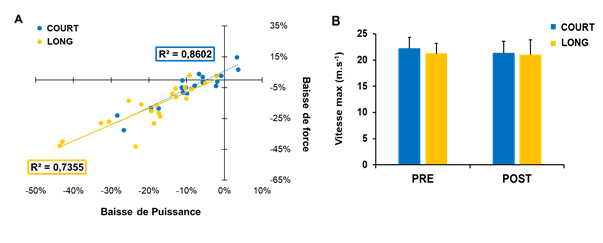
Figure 4. Correlation between decrease in maximal power and decrease in maximal strength between before and after UTMB events (panel A) and decrease in theoretical maximum contraction velocity (panel B).
The 5th article published in Eur J Appl Physiol (1st author: Frederic Sabater Pastor) focused on the modification of the energy cost with fatigue in trail (SHORT) and ultra-trail (LONG) runs, the energy cost being measured both in level running and in running with a gradient of +15%.
Contrary to what one may think, energy cost increased significantly with fatigue only for the SHORT distances (Figure 5A). This suggests that the exercise intensity more than the duration impacts running efficiency. Moreover, there was a significant correlation between running speed and the variation in energy cost. When the effect of slope was examined, there was a correlation between changes in energy cost on the flat and changes in uphill (Figure 6). Nevertheless, the magnitude of the changes was greater on the flat, possibly due to less use of muscle elasticity.
We took advantage of the gas exchange measurement to investigate the substrates used during running. As indicated by the decrease in respiratory exchange ratio (CO2 production divided by O2 consumption, Figure 5B), the percentage of energy coming from lipids was greater after the races. For example, a decrease in respiratory exchange ratio from 0.86 to 0.75 (as observed on average after the SHORT trails) reflects an increase in fat utilization from 45% of total energy to 83%. Our results show a greater decrease in the respiratory exchange ratio on the SHORT run, which could be due to a greater depletion of glycogen in the locomotor muscles as intensity increases, thus increasing the use of fat as an energy substrate.
Figure 5. Change in energy cost (panel A) and respiratory exchange ratio (panel B) measured in level and uphill running for the two distances: SHORT and LONG.
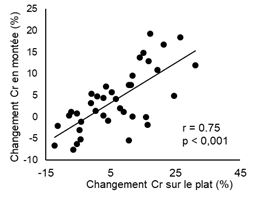 Figure 6. Correlation between changes in energy cost (Cr) in flat and uphill conditions.
Figure 6. Correlation between changes in energy cost (Cr) in flat and uphill conditions.
Finally, the 6th article (published in Int J Mol Sci, 1st author: Mélanie Robert) studied a parameter that has been little investigated in trail running: red blood cell deformability and blood viscosity. The main results are that red blood cell deformability, blood viscosity and hematocrit (percentage of red blood cells in the blood) decreased after the UTMB® but not after the MCC[1]. Our results indicate that the rheological behavior of blood is different between a trail and an ultra-trail. The low blood viscosity observed after UTMB® could facilitate blood flow to the muscles and optimize aerobic performance.
Perspectives
As is often the case in a scientific experiment, these results have to be confirmed by other studies. This is despite the difficulty in recruiting women because of their low participation, especially over long distances. In 2009, we established the recovery kinetics of neuromuscular function in men (Millet et al. PLOS One 2011). Although a few studies suggest that women may recover faster, this remains to be demonstrated in the context of trail and ultra-trail running. Furthermore, our preliminary results about the influence of sex on running intentions need to be reinforced with the help of specialists in the field of psychology.
————————————————————————————————————————————————————
Author: Guillaume Millet (Professor of Exercise Physiology Ÿ Director of the Inter-university Laboratory of Human Movement Biology (LIBM) • Professor and leader of the ActiFS Chair • Senior member, Institut Universitaire de France Ÿ Principal investigator of the UTMB 2019 study)
Investigators: Thibault Besson, John Temesi, Frederic Sabater Pastor, Jérôme Koral, Loïc Espeit, Léonard Féasson, Audrey Parent, Diana Rimaud, Jérémy Rossi, Callum Brownstein, Thomas Lapole, Vincent Martin, Nicolas Royer, Benjamin Singh, Giorgio Varesco, Marie Fanget, Lauriane Imbert, Djahid Kennouche, Clément Foschia, Mélanie Robert, Emeric Stauffer, Elie Nader, Sarah Skinner, Camille Boisson, Céline Renoux, Paul Robach, Philippe Joly, Philippe Connes, Robin Trama, Christophe Hautier, Frédérique Hintzy, Alexandre Fouré, Thomas Rupp.
Other articles (published, under review or in preparation)
- Skinner S, Nader E, Stauffer E, Robert M, Boisson C, Cibiel A, Foschia C, Féasson L, Robach P, Millet GY, Connes P. Differential impacts of trail and ultra-trail running on cytokine profiles: an observational study. Published in: Clinical Hemorheology and Microcirculation
- Trama R, Blache Y, Hintzy F, Rossi J, Millet GY, Hautier C. Does neuromuscular fatigue generated by mountain ultra-marathons alter foot impact and soft-tissue vibrations during running? In preparation.
- Fouré A, Besson T, Stauffer E, Skinner S, Féasson L, Connes P, Hautier C, Millet GY. Shear wave elastography reveals sex differences in muscle-tendon passive mechanical properties and indirectly quantifies the amount of muscle tissue damage after trail running races. Under review.
- Sabater Pastor F, Besson T, Varesco G, Parent A, Fanget M, Koral J, Foschia C, Rupp T, Rimaud D, Féasson F, Millet GY. Determining factors of trail running performance of various distances. In preparation.
Acknowledgements: the research team sends its warmest thanks to the organizers of the UTMB® (in particular Catherine and Michel Poletti) as well as to the National Ski and Mountaineering School of Chamonix (in particular Paul Robach).
Other running-related ongoing studies at LIBM:
- Effects of performance level (French National team vs. regional runners), sex, age (U21 team) and discipline (marathon vs. trail) on neuromuscular capacities and energy cost of running.
- Comparison of 3 hours of running vs 3 hours of cycling at the same relative intensity: influence on neuromuscular fatigue and performance.
- Effects of the trail technicity on the cardiorespiratory and biomechanical parameters.
- Effects of shoe stiffness on running biomechanics and fatigue
Do not hesitate to contact guillaume.millet @ univ-st-etienne.fr to receive more information on these projects.
[1] Pour des raisons techniques, seules ces deux courses étaient considérées pour cette partie de l’étude.

